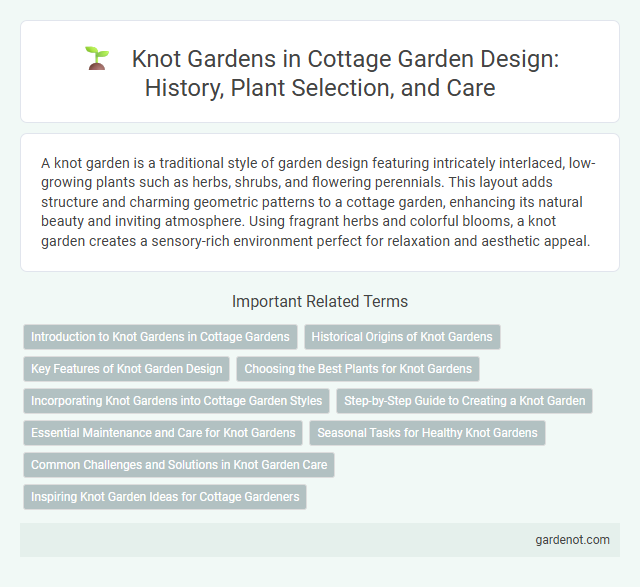A knot garden is a traditional style of garden design featuring intricately interlaced, low-growing plants such as herbs, shrubs, and flowering perennials. This layout adds structure and charming geometric patterns to a cottage garden, enhancing its natural beauty and inviting atmosphere. Using fragrant herbs and colorful blooms, a knot garden creates a sensory-rich environment perfect for relaxation and aesthetic appeal.
Introduction to Knot Gardens in Cottage Gardens
Knot gardens are traditional decorative garden designs featuring intricate patterns created with low, clipped hedges such as boxwood, forming geometric shapes reminiscent of embroidered fabric. Commonly incorporated into cottage gardens, knot gardens add structure and historical charm while complementing informal planting schemes with their precise, symmetrical layouts. These gardens originated in the Renaissance period and continue to enhance cottage landscapes by providing a focal point that balances naturalistic flower beds.
Historical Origins of Knot Gardens
Knot gardens originated in the late 16th century during the Tudor period in England, inspired by the intricate patterns of European Renaissance gardens. These gardens feature interlaced designs created with low hedges, traditionally boxwood, arranged in geometric shapes symbolizing order and refinement. Their historical roots reflect the era's fascination with symmetry, herb cultivation, and ornamental horticulture.
Key Features of Knot Garden Design
Knot garden design is characterized by intricate patterns created with low-growing, evergreen hedges such as boxwood or lavender, forming geometric shapes that resemble knotted ribbons. Paths of gravel or brick often separate the planted sections, enhancing the visual contrast and allowing easy access for maintenance. This style emphasizes symmetry, precision, and a timeless elegance that complements traditional cottage garden aesthetics.
Choosing the Best Plants for Knot Gardens
Selecting the best plants for knot gardens involves choosing low-growing, evergreen shrubs such as boxwood (Buxus sempervirens) for defining intricate patterns with crisp edges. Incorporating aromatic herbs like thyme, lavender, and rosemary enriches the sensory experience while maintaining the garden's structured appearance. Seasonal flowering plants like tulips or violas can be added for vibrant color contrasts within the geometric design.
Incorporating Knot Gardens into Cottage Garden Styles
Knot gardens, characterized by intricate patterns of low hedges such as boxwood, complement cottage garden styles by adding structured elegance to the informal planting scheme. Incorporating fragrant herbs like lavender, thyme, and rosemary within the knot patterns enhances sensory appeal and supports traditional cottage garden themes. This fusion creates a harmonious balance between meticulous design and the lush, natural charm typical of cottage gardens.
Step-by-Step Guide to Creating a Knot Garden
Creating a knot garden begins with selecting a flat, well-drained area and outlining its geometric design, typically consisting of interlacing patterns formed by low hedges like boxwood. Plant tightly clipped hedges in symmetrical, intricate shapes, ensuring pathways between each section for accessibility and maintenance. Incorporate aromatic herbs or colorful annuals within the compartments to enhance texture and fragrance, maintaining regular trimming to uphold the garden's precise, ornamental structure.
Essential Maintenance and Care for Knot Gardens
Essential maintenance for knot gardens involves regular pruning to maintain the intricate geometric patterns and prevent overgrowth of herbs and shrubs. Soil should be kept well-drained and nourished with organic compost to promote healthy plant growth and vibrant foliage. Consistent weeding and timely watering ensure the delicate balance of aesthetics and plant health crucial for the garden's structured design.
Seasonal Tasks for Healthy Knot Gardens
Maintaining a healthy knot garden requires regular seasonal tasks such as pruning boxwood hedges in early spring to encourage dense growth and prevent overgrowth. Summer involves weeding and watering to keep the soil moist and free from invasive plants that can disrupt the intricate patterns. In autumn, apply mulch to protect roots during winter and perform light trimming to maintain the garden's geometric structure.
Common Challenges and Solutions in Knot Garden Care
Knot gardens often face challenges such as overgrowth, weed invasion, and soil compaction, which hinder the precise geometric patterns essential to their design. Regular pruning combined with the use of organic mulch helps maintain plant health and definition, while aerating the soil and applying balanced fertilizers promote robust growth. Implementing integrated pest management and ensuring proper drainage also prevent common issues like fungal diseases and root rot, preserving the intricate structure of the knot garden.
Inspiring Knot Garden Ideas for Cottage Gardeners
Knot gardens feature intricate, symmetrical patterns created with low hedges such as boxwood, adding structured elegance to cottage gardens. Incorporating aromatic herbs like thyme, lavender, and rosemary within the geometric designs enhances both visual appeal and sensory enjoyment. Combining vibrant flowering plants like tulips or violas with neatly clipped greenery creates a timeless, inspiring focal point for any cottage garden.
Knot garden Infographic

 gardenot.com
gardenot.com